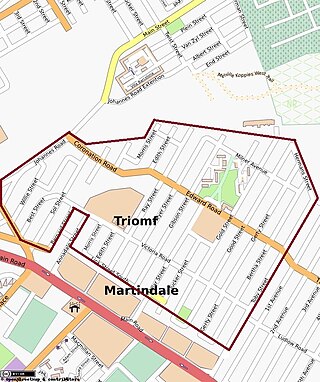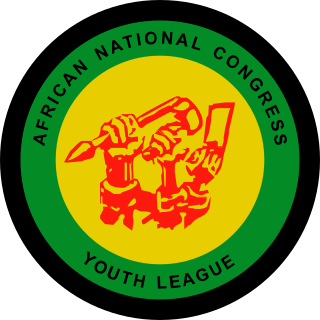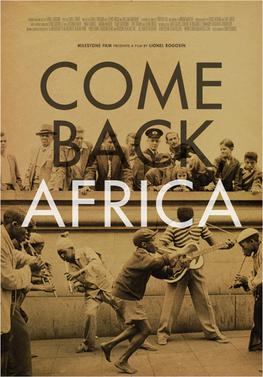Alfred Bathini Xuma, OLG, commonly referred to by his initials as AB Xuma, was the first black South African to become a medical doctor, as well as a leader, activist and president-general of the African National Congress (ANC) from 1940 to 1949. He was a member of the African American founded Alpha Phi Alpha fraternity.

Johannesburg is a large city in Gauteng Province of South Africa. It was established as a small village controlled by a Health Committee in 1886 with the discovery of an outcrop of a gold reef on the farm Langlaagte. The population of the city grew rapidly, becoming a municipality in 1898. In 1928 it became a city making Johannesburg the largest city in South Africa. In 2002 it joined ten other municipalities to form the City of Johannesburg Metropolitan Municipality. Today, it is a centre for learning and entertainment for all of South Africa. It is also the capital city of Gauteng.

Sophiatown, also known as Sof'town or Kofifi, is a suburb of Johannesburg, South Africa. Sophiatown was a black cultural hub that was destroyed under apartheid, It produced some of South Africa's most famous writers, musicians, politicians and artists. Rebuilt under the name of Triomf, and in 2006 officially returned to its original name. Sophiatown was one of the oldest black areas in Johannesburg and its destruction represents some of the excesses of South Africa under apartheid.
Yusuf Mohamed Dadoo was a South African Communist and an anti-apartheid activist. During his life, he was chair of both the South African Indian Congress and the South African Communist Party, as well as being a major proponent of co-operation between those organisations and the African National Congress. He was a leader of the Defiance Campaign and a defendant at the Treason Trial in 1956. His last days were spent in exile in London, where he is buried at Highgate Cemetery; a few metres away from the Tomb of Karl Marx.

The African National Congress Youth League (ANCYL) is the youth wing of the African National Congress (ANC). As set out in its constitution, the ANC Youth League is led by a National Executive Committee (NEC) and a National Working Committee (NWC).

DRUM is a South African online family magazine mainly aimed at black readers, containing market news, entertainment and feature articles. It has two sister magazines: Huisgenoot and YOU.
William Modisane, better known as Bloke Modisane, was a South African writer, actor and journalist.

Come Back, Africa is a 1959 film, the second feature-length film written, produced, and directed by American independent filmmaker Lionel Rogosin. The film had a profound effect on African cinema, and remains of great historical and cultural importance as a document preserving the heritage of the townships in South Africa in the 1950s. It may be classified as reportage, documentary, historical movie or political cinema, since it portrays real events and people. On the other hand, it reveals an interpretation of meaningful social facts and a strong ethical assumption towards human behaviours like racism.
Joseph Mbuku Nhlanhla was an African National Congress national executive and the former South African Intelligence Minister.

Kate Molale was a South African political activist, between 1970 and 1975 she represented the ANC Women's League/Women's Section in the Women's International Democratic Federation.

The Natives Resettlement Act, Act No 19 of 1954, formed part of the apartheid system of racial segregation in South Africa. It permitted the removal of blacks from any area within and next to the magisterial district of Johannesburg by the South African government. This act was designed to remove blacks from Sophiatown to Meadowlands.
Milner Langa Kabane Fort Hare Alumni, GCOB was an educator, newspaper editor, human rights activist and a pioneer of the first "Bill of Rights" version in South Africa, which was unanimously adopted by many progressive organisations including the African National Congress in 1943.

Orlando East Public Library is the oldest library in Soweto in South Africa.

The Rand Club is a private members' club in Johannesburg, South Africa, founded in October 1887. The current (third) clubhouse was designed by architects Leck & Emley in 1902 and its construction completed in 1904. Cecil John Rhodes helped to select the location.

House Hains is an historic residence in the Yeoville section of Johannesburg, South Africa.

Dorkay House is situated on Portion 168 of Farm Turnfontein at 5–7 Eloff Street, Johannesburg, South Africa. It was constructed in 1952 and was designed by architect Colman Segal (1923–1988). It takes its name from the original owner, Dora Kotzen.
Ismail Ahmed Cachalia (1908-2003), popularly known as Moulvi, was a South African political activist and a leader of Transvaal Indian Congress and the African National Congress. He was one of the leaders of the Indian Passive Resistance Campaign of 1946 and the Defiance Campaign in 1952. The Government of India awarded the fourth highest Indian civilian honour of Padma Shri in 1977.
Madie Hall Xuma was an African American educator and social activist who emigrated to South Africa. She was called a 'mother of the nation'. Her husband, A.B. Xuma, was a president of the African National Congress (ANC) from 1940 to 1949.
Xuma is a surname. Notable people with the name include:

The Transvaal Memorial Hospital for Children, based in Johannesburg, was the first dedicated children's hospital in South Africa when it opened in 1923. The hospital would remain open until 1978 when its functions were moved to the then newly opened Johannesburg General Hospital. The building is a heritage listed monument and parts of the building are currently used by community groups dedicated to the service of children.













